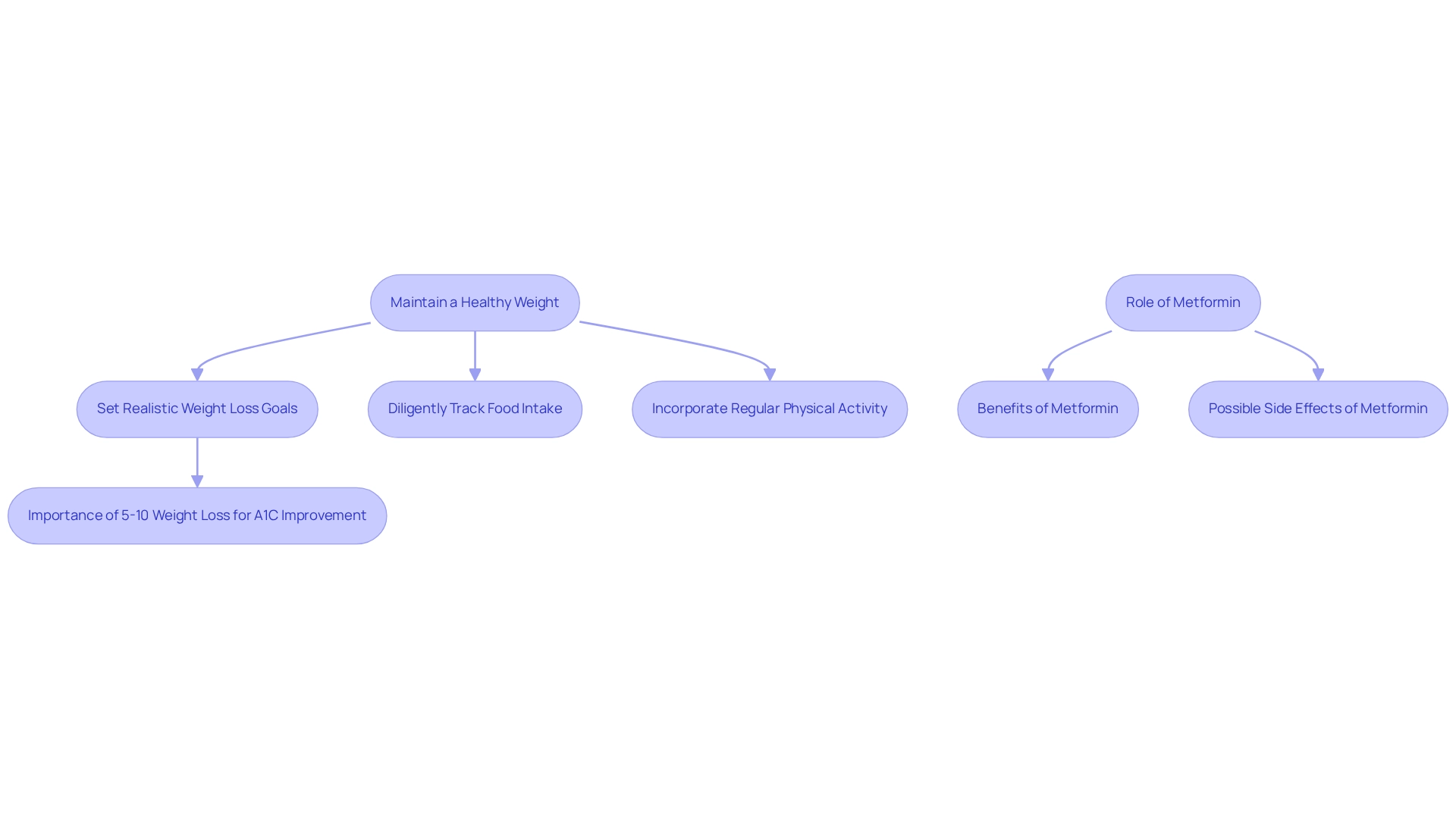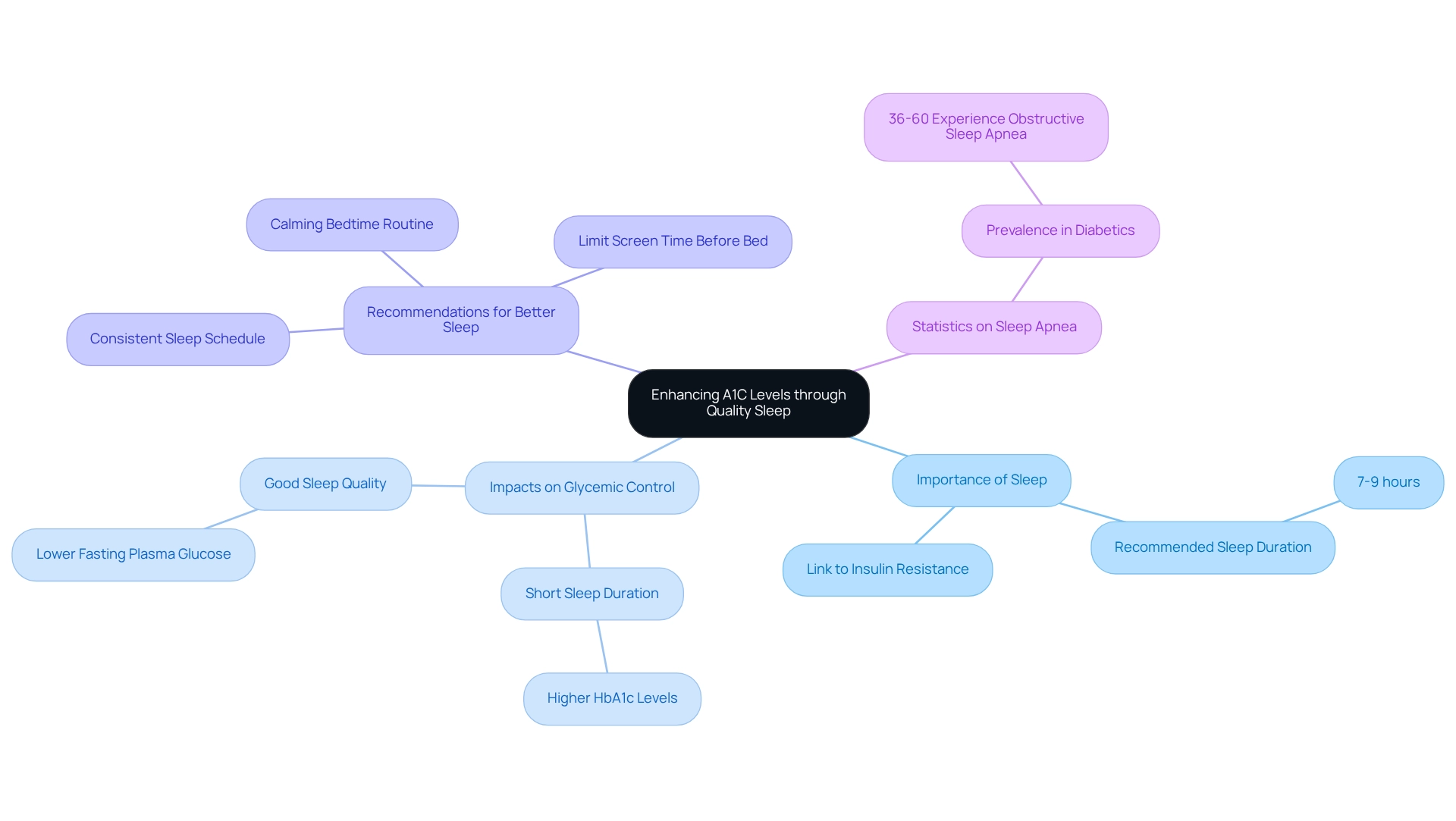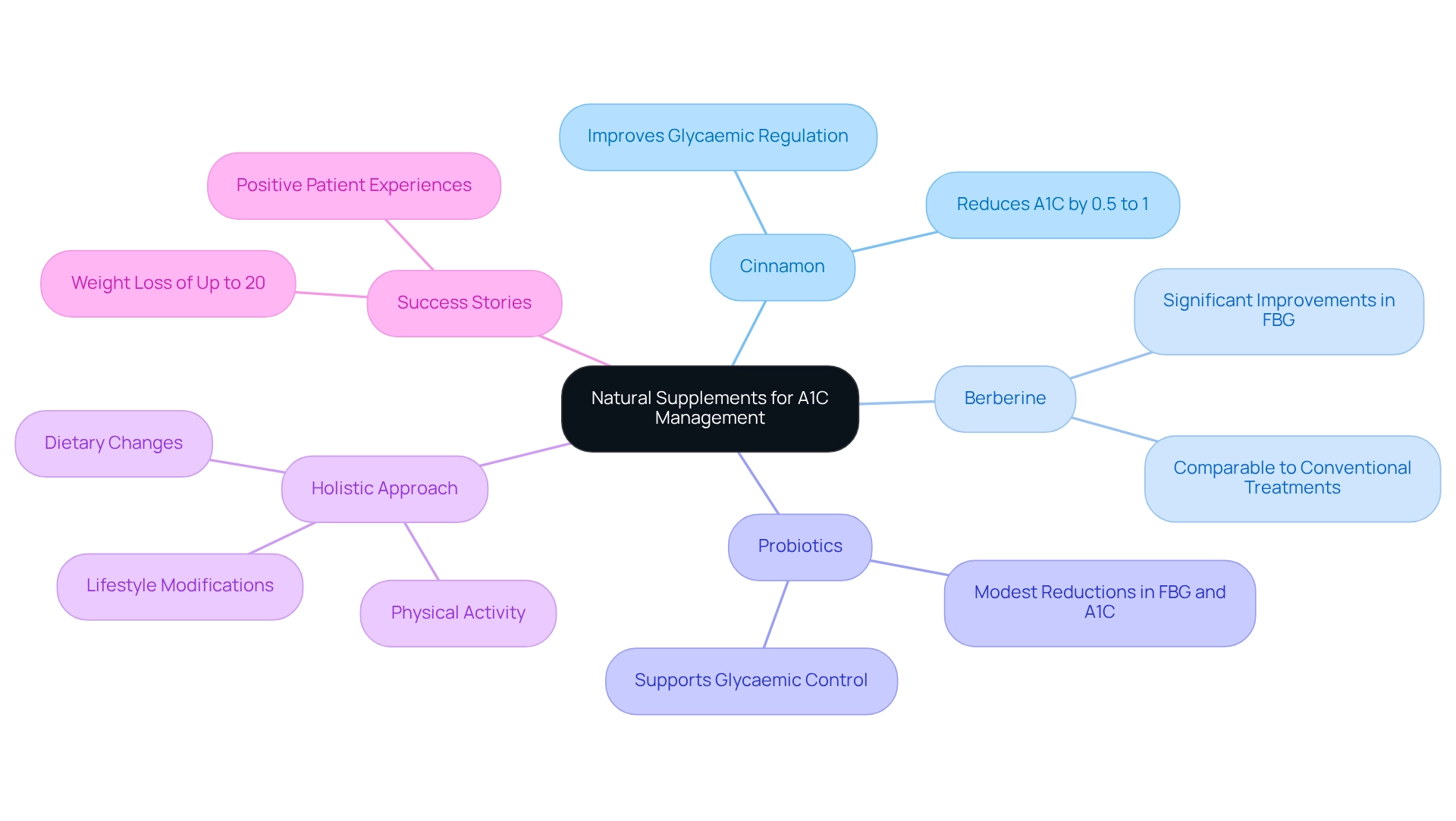Overview
This article delves into effective strategies for naturally lowering A1C levels, highlighting the crucial role of:
- Dietary adjustments
- Regular exercise
- Stress management
- Hydration
- Quality sleep
- Natural supplements
- Collaboration with healthcare providers
Each method is backed by research and expert opinions, demonstrating how these lifestyle changes can profoundly enhance blood sugar control and overall well-being for those managing diabetes.
We understand that navigating diabetes can feel overwhelming at times. It’s important to know that you’re not alone in this journey. By making small, manageable adjustments to your daily routine, you can take significant steps toward better health. Imagine the relief of seeing your A1C levels improve through simple yet effective changes.
Consider how incorporating a balanced diet and regular physical activity can transform your daily life. Have you thought about how stress management techniques might ease your mind and improve your overall health? Remember, quality sleep is not just a luxury; it’s a vital component of your wellness journey. Each of these strategies offers a pathway to better control of your blood sugar levels.
As you explore these options, remember that natural supplements can also play a supportive role. We encourage you to discuss these choices with your healthcare provider to tailor a plan that works best for you. Together, we can achieve your health goals and empower you on this journey.
In conclusion, embracing these lifestyle changes can lead to a brighter, healthier future. We’re here for you every step of the way, and with determination and support, you can make a meaningful impact on your health.
Introduction
In the intricate landscape of diabetes management, understanding A1C levels is crucial for those seeking to maintain their health. A1C, or glycated hemoglobin, offers insight into average blood sugar levels over the past two to three months. It serves not only as a diagnostic tool but also as an essential metric for monitoring the progression of diabetes.
With alarming statistics showing that nearly half of adults with diabetes struggle to keep their A1C levels in check, the need for effective strategies has never been more pressing. Have you considered how dietary adjustments, regular exercise, and stress management can play a role in your journey? Collaborating with healthcare providers is also key to achieving your goals.
This article explores practical approaches and expert insights that empower you to take control of your diabetes management. Together, we can foster a path toward improved health and well-being, encouraging you to embrace the steps necessary for a healthier future.
Understanding A1C Levels: What They Are and Why They Matter
A1C values, also known as glycated hemoglobin values, serve as a vital indicator of your average blood sugar readings over the past two to three months. This test is crucial not only for identifying diabetes but also for tracking its progression. A typical A1C value is categorized as below 5.7%.
If your A1C falls between 5.7% and 6.4%, it suggests prediabetes, while an A1C of 6.5% or above confirms a diagnosis of the condition. Understanding these thresholds is essential for effectively managing your blood sugar. Elevated A1C readings are linked to increased risks of severe complications, including heart disease and nerve injury, which is why staying informed is so important.
Recent studies have highlighted a concerning trend: approximately 47.4% of adults with diabetes report A1C levels of 7.0% or higher, indicating poor blood sugar control. This statistic underscores the urgent need for improved education and management strategies tailored to support individuals across various demographics. As Charles “Chuck” Henderson, the ADA’s chief executive officer, states, “Enhancing the lives of individuals impacted by this condition is a key part of the ADA’s mission.”
The ADA is here to provide the reliable assistance you need to manage diabetes effectively and thrive until a cure is discovered. In this context, Metformin emerges as a valuable tool for those looking to lower their A1C values. FDA-approved for controlling blood sugar in adults with type 2 diabetes, Metformin works by reducing liver sugar production and improving muscle cell responsiveness to insulin. This dual effect not only enhances glucose utilization but also decreases insulin resistance, leading to better blood sugar control.
While Metformin is not specifically approved for weight loss, many obesity specialists prescribe it off-label, believing it can help with weight management by regulating insulin response and curbing cravings. Typically, Metformin is taken by mouth, either with or after meals to minimize the chance of stomach upset. Your doctor will prescribe the right dosage based on your needs, and it may be taken once or twice daily. Remember to follow your dosing schedule to maximize the effectiveness of the medication.
Possible side effects may include stomach discomfort such as nausea or gas, potential diarrhea or loose stools, decreased vitamin B12 levels with long-term use, a metallic taste in the mouth, and, in rare cases, severe lactic acidosis if not used correctly.
Experts emphasize the importance of regular A1C testing and exploring various ways to lower A1C as part of a comprehensive diabetes care plan. Top endocrinologists agree that identifying strategies to lower A1C figures within target ranges is crucial for decreasing the risk of complications and enhancing overall wellness outcomes. The connection between A1C readings and average blood sugar measurements is direct; higher A1C readings correlate with increased blood glucose, making it essential for you to monitor and manage your values proactively.
In summary, A1C values are more than just numbers; they reflect your wellness condition and play a crucial role in diabetes management. By understanding and actively overseeing these aspects, you can significantly influence your long-term health and well-being. The ADA’s advocacy, education, and research efforts are dedicated to supporting you on this journey, reminding you that together, we can achieve your goals.
Optimize Your Diet: Foods That Help Lower A1C
Including fiber-rich foods in your diet is one of the best ways to lower A1C values. Whole grains, legumes, and a variety of vegetables play a crucial role in this process. Leafy greens, berries, and nuts are particularly beneficial due to their high fiber content and low glycemic index.
Have you considered how decreasing the consumption of refined carbohydrates and added sugars can help sustain stable blood glucose levels? A practical approach is to fill half your plate with non-starchy vegetables. Not only do they provide fiber, but they also deliver essential nutrients. Incorporating lean proteins can further assist in stabilizing blood sugar, resulting in a balanced meal that promotes overall health.
Furthermore, examining caloric menus of 1200 or 1800 calories can assist in portion control and dietary management. This is especially crucial for those aiming to reduce their A1C values effectively. Remember, every small change counts!
Recent research emphasizes the substantial effect of dietary fiber on A1C values. Studies indicate that increased fiber consumption is linked to better blood sugar management. For instance, people who eat a diet high in fiber may see a decrease in HbA1c values, leading to improved long-term health results. Success stories abound, with numerous individuals reporting enhanced A1C readings after making dietary adjustments that emphasize fiber-rich foods.
Nutritionists emphasize the importance of these dietary adjustments. As Arlene Semeco, MS, RD, wisely states, “From dietary adjustments to medicinal foods, here’s what you need to understand to manage blood sugar amounts in a natural way.” This comprehensive method not only provides effective ways to lower A1C numbers but also encourages overall wellness, making it a sustainable option for individuals seeking to enhance their health naturally.
Moreover, have you thought about adding citrus fruits to your diet? They can be especially advantageous; although they contain natural sugars, they rank low to medium on the glycemic index. Plus, they are abundant in fiber and helpful compounds such as naringenin, which may enhance insulin sensitivity and lower HbA1c values. Together, we can achieve your goals for better health!
Incorporate Regular Exercise: The Key to Lowering A1C
Consistent physical activity is a vital way to lower A1C values, as it enhances insulin sensitivity and promotes better blood sugar management. We recommend engaging in at least 150 minutes of moderate aerobic exercise each week, complemented by strength training on two separate days. Activities like brisk walking, cycling, and swimming can be particularly effective.
Additionally, simple habits, such as taking a walk after meals, can significantly reduce post-meal blood sugar spikes.
At Minimal, we understand that a comprehensive approach is essential for lasting wellness improvements. Our customized health and wellness programs include:
- Weight loss prescriptions
- Individualized fitness plans
- Nutrition advice
- Breathwork
- Acupuncture
- Continuous glucose monitoring
Each is a valuable tool for lowering A1C values. Recent studies show that structured exercise programs can lead to meaningful improvements in A1C readings.
For example, a statistical analysis of exercise program outcomes utilized mixed ANOVA to evaluate changes over time and differences between groups, demonstrating significant reductions in HbA1c and blood glucose levels. Interestingly, the analysis found no significant interactions between the type of exercise and the results, indicating that both aerobic and resistance training offer benefits.
Success stories abound, with many individuals reporting substantial improvements in their A1C values through regular physical activity. In fact, data from over 70,000 patients involved in wellness programs reveal that clients can lose up to 20% of their weight, closely linked to better glycemic control. This research is groundbreaking as it is the first to use MDC as a measure for exercise interventions in glycemic control, underscoring the need for ongoing exploration in this area.
Experts emphasize that consistent exercise is one of the top ways to lower A1C levels while also enhancing overall wellness. As Dr. Chance Miller points out, personalized attention from healthcare providers can boost the effectiveness of exercise regimens, ensuring individuals receive tailored support on their journey to improved health.
By incorporating various forms of physical activity into daily routines and benefiting from the comprehensive support offered by Minimal, individuals can achieve sustainable results in managing their diabetes. If you’re ready to take the next step, we invite you to reach out to us at (872) 228 – 2358 or email [email protected]. Together, we can achieve your goals.
Maintain a Healthy Weight: Strategies for Success
Sustaining a healthy weight is crucial for effectively lowering A1C readings. Have you ever considered how even a modest weight loss of 5-10% can lead to substantial improvements in blood sugar control? Research shows that every percentage point reduction in mean A1C correlates to a 37% decrease in the risk of microvascular complications and a 21% reduction in the risk of any diabetes-related endpoint and diabetes-related deaths. To achieve this, it’s important to:
- Set realistic weight loss goals
- Diligently track your food intake
- Incorporate regular physical activity into your routine
Collaborating with a healthcare provider or nutritionist can provide personalized guidance tailored to your needs, enhancing your likelihood of success. As Dr. Chance Miller, Head of Weight Loss at Minimal, emphasizes, “Clients appreciate the personalized attention from a dedicated care team, which includes physicians like Dr. Chance Miller, who emphasize transformative care.” This comprehensive approach not only aids in weight management but also promotes long-term health advantages, making it one of the crucial ways to lower A1C for those seeking to enhance their values.
Additionally, Metformin, an FDA-approved drug for controlling blood sugar in adults with type 2 diabetes, can assist in weight management by enhancing insulin sensitivity and decreasing cravings. It’s important to follow the prescribed dosage and administration guidelines to maximize its effectiveness. While Metformin can be beneficial, possible side effects include:
- Stomach discomfort
- Diarrhea
- Diminished vitamin B12 levels with prolonged use
- A rare but serious risk of lactic acidosis if not used correctly
A study titled “Weight Change Trajectories in Type 2 Diabetes” found that initial weight loss can lead to improved glycemic control, highlighting the lasting therapeutic benefits of weight management. Understanding the dynamics of weight management over time, including the experiences of both weight-gain and weight-loss groups, can provide valuable insights into effective ways to lower A1C and sustain a healthy weight. Remember, together, we can achieve your goals, and every step you take is a step toward a healthier future.
Manage Stress Effectively: Techniques to Lower A1C
Effective stress management is vital for maintaining stable blood sugar readings, especially for those managing diabetes. Have you ever noticed how stress can impact your glucose levels? Research shows that stress can significantly affect glucose amounts. Prolonged stress leads to elevated cortisol levels, which can increase blood sugar. For instance, a study from The Ohio State University Wexner Medical Center found a direct correlation between high cortisol levels and increased glucose levels over a six-year period.
This finding highlights the importance of integrating stress relief techniques into the management of blood sugar-related conditions. Complications of type II diabetes, such as nerve damage, kidney damage, and vision issues, remind us of the serious consequences of poorly controlled blood sugar levels. Thus, effective stress management becomes even more essential.
Techniques like mindfulness meditation, yoga, and deep breathing exercises are effective in reducing stress and enhancing emotional well-being. Mindfulness practices not only promote relaxation but also foster self-awareness, helping you manage your responses to stressors more effectively. Have you tried yoga? It has gained recognition for its dual benefits of physical activity and stress reduction, making it a powerful tool for lowering A1C levels.
Dr. Marina Basina, an expert in the field, reassures us that a prediabetes diagnosis does not mean you will develop type 2 diabetes. This reinforces the importance of proactive management. Consistent physical activity acts as a natural stress reducer, enhancing overall wellness. Activities such as yoga and walking, as suggested in the Ohio State study, can effectively reduce cortisol levels and improve blood sugar regulation.
Allocating specific time daily for relaxation and self-care can significantly enhance your emotional well-being, which is crucial for effective diabetes management. By incorporating these stress management methods into your daily routine, you can discover ways to lower A1C values and improve your overall quality of life. Remember, together, we can achieve your goals.
Stay Hydrated: The Overlooked Factor in A1C Control
Staying adequately hydrated is essential for your overall health and is one of the most important ways to lower A1C values. We recommend aiming for at least 8-10 cups of water daily. Proper hydration supports your kidneys in filtering excess sugar from your bloodstream, which is especially crucial for those managing blood sugar levels. Remember, dehydration can lead to increased glucose amounts in your body.
Carrying a water bottle with you can serve as a gentle reminder to drink water consistently throughout the day. Have you ever noticed how easy it is to forget to hydrate when you’re busy?
Recent studies have shown that increasing your water intake can positively impact your blood sugar control. For instance, a structured water intake intervention demonstrated a notable reduction in glucose concentration among participants, with blood samples of 33 ml drawn for HbA1c testing. This highlights the varying effects of hydration on different populations. Specifically, research suggests that the black African population with pre-diabetes may benefit from increased plain water intake to help prevent the onset of type 2 diabetes.
Experts emphasize the significance of hydration in regulating blood sugar. Even small increases in water consumption can be valuable in lowering A1C readings. As Ginger Vieira, an author and advocate living with type 1 diabetes, states, “Hydration is a key factor in managing blood sugar values effectively.” Success stories from individuals who have increased their water consumption reveal that many have found ways to lower their A1C values as a result.
Therefore, ensuring sufficient hydration is not just a suggestion for well-being; it’s an important step in effectively managing diabetes and lowering A1C levels. The research findings discussed are supported by contributions from the Economic and Social Research Council, adding credibility to the importance of hydration in blood sugar control. Together, we can achieve your health goals, one sip at a time.
Prioritize Quality Sleep: Enhancing A1C Levels
Prioritizing quality sleep is one of the most important ways to lower A1C values. Have you ever felt overwhelmed by the challenges of managing your health? Research indicates that adults should aim for 7-9 hours of restful sleep each night to optimize metabolic health. Inadequate sleep can lead to insulin resistance, which subsequently increases blood sugar concentrations.
A systematic review of studies has shown that short sleep duration is linked to significantly higher HbA1c values, while good sleep quality correlates with lower fasting plasma glucose levels. It’s important to note that further studies are needed to confirm these findings and establish a potential causal relationship between sleep and glycemic control.
To enhance your sleep quality, consider:
- Establishing a consistent sleep schedule
- Creating a calming bedtime routine
- Limiting screen time before bed
Did you know that approximately 36-60% of diabetics experience obstructive sleep apnea? This condition can further complicate glycemic control.
Addressing sleep issues is essential. Improved sleep has been linked to better blood sugar management, and we’re here to support you in this journey.
Expert opinions underscore the relationship between sleep quality and insulin resistance, emphasizing that good sleep can enhance metabolic function. As Dr. Chance Miller highlights, “Clients appreciate the personalized attention from a dedicated care team, which includes physicians like me, who emphasize transformative care.”
A recent study focusing on Asian patients with type 2 diabetes found that both sleep duration and quality play significant roles in glycemic control. By prioritizing sleep, individuals can discover ways to lower A1C values naturally. Together, we can achieve your goals for a healthier life.
Explore Natural Supplements: Aiding Your A1C Journey
Natural supplements have emerged as a promising option for those looking to lower their A1C values, with numerous studies highlighting their potential benefits. Among these, cinnamon and berberine stand out for their effectiveness in managing blood sugar. Research indicates that cinnamon can improve glycaemic regulation, with some studies showing reductions in A1C values by up to 0.5% to 1% when incorporated into a daily routine.
Berberine, a powerful supplement, has been associated with significant improvements in fasting blood glucose and A1C measurements, often comparable to conventional treatments for blood sugar management.
A meta-analysis by Cao et al. that examined the effects of probiotics on glycaemic control further supports the use of natural supplements. This study found that probiotic supplementation was linked to slight decreases in both fasting blood glucose (FBG) and A1C levels, suggesting that these supplements can play a role in managing blood sugar levels.
The interest in natural supplements continues to rise, with many healthcare providers encouraging their use alongside traditional treatments. Experts stress the importance of a holistic approach to diabetes management, which encompasses dietary changes, physical activity, and various methods to lower A1C through effective supplements. Dr. Chance Miller emphasizes, “Combining lifestyle changes with supplements such as cinnamon and berberine can lead to improved wellness outcomes for patients.”
Success stories are plentiful, with many individuals sharing their journeys of significant improvements in A1C levels after incorporating these natural supplements into their daily lives. Notably, clients at Minimal have reported weight loss of up to 20%, based on data from over 70,000 patients who have participated for at least six months. This highlights the effectiveness of lifestyle modifications alongside supplement use, as Minimal offers a variety of wellness services, including personalized weight loss solutions, nutrition guidance, Continuous Glucose Monitoring, Functional Medicine, and comprehensive wellness treatments.
However, it’s essential to consult with a healthcare provider before beginning any new supplement regimen to ensure safety and effectiveness, especially regarding interactions with existing treatments. By exploring these natural alternatives within the framework of Minimal’s integrative health solutions, individuals can take meaningful steps toward better managing their condition and achieving their health goals. Together, we can navigate this journey toward wellness.
Monitor Your A1C Levels: Tracking Progress for Better Control
Consistent tracking of A1C values is essential for successfully managing blood sugar, representing a key way to lower A1C in personalized weight loss strategies. If you have high blood sugar, it is advised to have your A1C examined at least twice a year; however, more frequent testing may be necessary if your readings aren’t within the target range. This proactive approach empowers both you and your healthcare provider to make informed decisions regarding treatment plans and necessary lifestyle adjustments, including effective strategies for lowering A1C through weight management.
The impact of consistent A1C monitoring on your well-being cannot be overstated. Studies show that tighter glucose control, as reflected by A1C levels in the 7% range or lower, is linked to a significant reduction—between 35% to 76%—in microvascular complications for patients with type 1 diabetes. This statistic underscores the importance of regular testing as a preventive measure against serious medical issues and supports the overall goal of achieving a healthier weight.
Success stories abound, with many patients sharing how careful tracking has led to enhanced management of their well-being. A recent case study titled “Enhancing Healthcare Team Outcomes” highlighted the importance of interprofessional collaboration in managing diabetes-related care. It emphasized that healthcare teams, including nurses and pharmacists, play a vital role in effectively monitoring A1C levels. This collaborative approach not only improves patient outcomes but also fosters a deeper understanding of each individual’s unique health journey, including their weight loss aspirations.
Experts in blood sugar management recommend regular A1C testing to stay informed about your glycemic control. As Dr. Chance Miller, a physician at Minimal, shares, “Clients appreciate the personalized attention from a dedicated care team, which includes physicians like myself, who emphasize transformative care.”
This highlights the significance of tailored care in effectively managing blood sugar levels and identifying ways to lower A1C while also addressing weight loss needs.
As we look ahead to 2025, the importance of A1C monitoring remains crucial. Statistics indicate that many individuals with blood sugar challenges do not adhere to recommended testing frequencies. By prioritizing regular A1C assessments, you can take charge of your well-being, ensuring you stay on the path to improved diabetes management and overall wellness—essential for those seeking effective weight loss solutions through Minimal’s holistic approach. Together, we can achieve your goals.
Collaborate with Healthcare Providers: Your Partner in A1C Management
Collaborating closely with healthcare providers is essential for effectively managing A1C levels. At Minimal, we take this a step further by integrating a holistic wellness approach. Our offerings include:
- Weight loss prescriptions
- Tailored fitness training
- Nutrition advice
- Breathwork
- Acupuncture
- Additional options—all designed to assist you on your wellness journey.
Frequent consultations with your physician, nutritionist, or educator can provide personalized advice and support, helping you establish achievable wellness objectives and adjust medications as necessary.
This cooperative method not only promotes a deeper understanding of your personal medical needs but also enhances compliance with treatment plans. Have you ever felt overwhelmed by managing your health? Recent research underscores the importance of interprofessional team care in improving outcomes for adults with type 2 diabetes. By embracing patient-centered care principles—such as shared goals and open communication—healthcare teams have reported increased patient satisfaction and better overall health outcomes. For instance, a review highlighted that when patients actively engage with their care teams, they experience improved adherence to their management plans.
At Minimal, we emphasize the creation of Patient-Centered Networks (PCNs) to enhance access to primary care and improve care for individuals with chronic conditions, including blood sugar regulation issues. Did you know that effective collaboration can lead to significant improvements in lowering A1C? A non-randomized clinical trial demonstrated that team-based approaches to managing blood sugar conditions markedly enhanced the quality of care for patients. This highlights the vital role healthcare professionals play in supporting patients on their journey to manage blood sugar conditions.
Our weight loss program begins with a consultation to evaluate your health and establish the most suitable treatment plan, which may include prescription options like Semaglutide. Success stories abound, showcasing how patient-provider partnerships have transformed diabetes outcomes. Many individuals have reported substantial improvements in their A1C levels by finding effective ways to lower A1C through consistent communication and support from their healthcare teams.
Furthermore, treatment satisfaction scores range from a minimum of 1.16 to a maximum of 4.89, reflecting the positive impact of collaborative care on patient experiences. By prioritizing collaboration and utilizing the comprehensive services at Minimal, you can enhance your A1C management and explore various ways to lower A1C while working towards achieving your health goals more effectively. If you need additional help, we’re here for you. Connect with us in three ways:
- Phone: (872) 228 – 2358
- Email: [email protected].
As the International Diabetes Federation (IDF) warns, diabetes is ‘spiraling out of control,’ highlighting the urgency of effective management and the crucial role of healthcare providers in addressing this critical issue. Together, we can achieve your goals.
Conclusion
Understanding and managing A1C levels is vital for individuals living with diabetes, as these levels serve as a key indicator of blood sugar control over time. Regular A1C testing, dietary adjustments, exercise, stress management, hydration, and quality sleep are essential in maintaining optimal A1C levels. Each of these factors plays a significant role in your overall health and can substantially reduce the risk of diabetes-related complications.
Have you considered incorporating fiber-rich foods and engaging in regular physical activity? Maintaining a healthy weight is another essential strategy that can lead to improved A1C levels. Often overlooked, effective stress management and proper hydration are critical components of diabetes care. Prioritizing quality sleep can further enhance your metabolic health, supporting better blood sugar control.
Collaboration with healthcare providers is also crucial in your journey toward effective diabetes management. By fostering a strong partnership with your healthcare team, you can receive personalized guidance tailored to your unique health needs, ultimately leading to better outcomes.
Taking proactive steps in managing A1C levels not only empowers you but also paves the way for a healthier future. Together, we can achieve your goals through the integration of lifestyle changes, medical support, and continuous education, significantly impacting your long-term well-being. Remember, we’re here for you, and every small step counts on this journey.
Frequently Asked Questions
What are A1C values and why are they important?
A1C values, also known as glycated hemoglobin values, indicate average blood sugar readings over the past two to three months. They are crucial for identifying diabetes and tracking its progression.
What do different A1C value ranges indicate?
An A1C value below 5.7% is considered normal. Values between 5.7% and 6.4% suggest prediabetes, while an A1C of 6.5% or above confirms a diabetes diagnosis.
What are the risks associated with elevated A1C readings?
Elevated A1C readings are linked to increased risks of severe complications, including heart disease and nerve injury.
What percentage of adults with diabetes report A1C levels of 7.0% or higher?
Approximately 47.4% of adults with diabetes report A1C levels of 7.0% or higher, indicating poor blood sugar control.
How can Metformin help in managing A1C values?
Metformin is FDA-approved for controlling blood sugar in adults with type 2 diabetes. It reduces liver sugar production and improves muscle cell responsiveness to insulin, leading to better blood sugar control.
What are the common side effects of Metformin?
Possible side effects of Metformin include stomach discomfort, nausea, gas, diarrhea, decreased vitamin B12 levels with long-term use, a metallic taste in the mouth, and in rare cases, severe lactic acidosis.
How can dietary changes help lower A1C values?
Including fiber-rich foods such as whole grains, legumes, leafy greens, berries, and nuts can help lower A1C values. Reducing refined carbohydrates and added sugars is also beneficial.
What role does physical activity play in managing A1C values?
Consistent physical activity enhances insulin sensitivity and promotes better blood sugar management. Engaging in at least 150 minutes of moderate aerobic exercise weekly is recommended.
What are some examples of effective physical activities for lowering A1C?
Effective activities include brisk walking, cycling, swimming, and strength training.
How can individuals achieve better health outcomes in managing diabetes?
By understanding and actively monitoring A1C values, making dietary adjustments, engaging in regular physical activity, and seeking tailored support from healthcare providers, individuals can significantly influence their long-term health and well-being.























